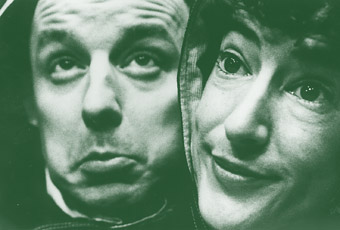Funny things can happen
Mary-Ann Robinson, La Mama's Explorations

John Britton & Hilary Elliott, Time and Tide
Asimov says that the most exciting phrase to hear in science is not “Eureka!” (I found it!) but “That’s funny…” Perhaps it is also the way with creativity where exploration, experimentation and mistakes evolve into new forms of expression. Funny things can happen in the spaces left by departures from convention. La Mama’s season of Explorations offers an umbrella for the presentation of works which are allowed such departures.
Synchronised Drowning was first presented at the 1999 Festival of Contemporary Arts in Canberra. This incarnation is a polished piece, tightly directed by Emma Newman with humour and whimsy in a space evocative of swimming pools, with change room cubicles, that peculiar light on pool water and starting blocks. The fears and delights of swimming are explored—fear of the water and the people in it, fear of going under, the pleasure of endorphins and the etiquette of the public pool. Instead of narrative, the work shifts through a series of people and their stories of interactions at the pool, children caught in a rip, sinking in a crowded motel pool. There is a touch of the all-Aussie Olympics, a race beautifully recreated with media commentary built into the dash for gold. Some of the physical work captures the liquidity of water in the human body—a breaking wave of arms and hands, a body floating. Elsewhere, the repeated use of counting and the human breath as a focus—holding breath or breathing to a rhythm—gives the work a meditative quality. Although the performers hint at intensity—“Water is so emotional”—this piece is generally slick and easy. Near the end, a long hug, people washing and getting wet, is less comfortable but hinted at the possibilities of departing further from convention.
Time and Tide (John Britton and Hilary Elliott) tells a Seachange story of Paul and Judy, leaving the familiar world of city work to pursue a dream. They move to an island to broadcast from a tin-shack radio station (Radio Atlantis) but never know if anyone is listening. Nobody phones. Their dream is gradually eroded by the rising tide, of isolation and (perhaps) the death of their child. There are ‘time warps’ in the plot where things may or may not have happened. Increasingly, Judy’s broadcasts are personal calls for contact and connection to the world. Paul maintains his desire to change the world, desperate to be noticed. Throughout this piece, dialogue routinely gives way to a form of movement as emotional expression. This physicalisation of subtext is intense, athletic and disciplined but not often surprising. It tends to happen between text, in lumps rather than blending with it. John Fenelon’s original live music, a significant part of the performance, is screened from the audience.
Clean As You Go is a wild, exciting piece which messes with everything. The audience are given protective gowns or gloves upon entry into a space dirtied with broken glass and soil. A sign invites us to sit anywhere or move around as the cleaning begins. Good humour is established between a slightly uncomfortable audience and performers who offer water, flowers to smell, newspaper to sit on. Performers turn lights—not ‘lighting’—on and off as required. Justin Leonard’s compelling and dreamlike text pieces are presented in darkness. The performance is interrupted by the traditional La Mama raffle, 20 minutes in. Clean As You Go is loosely scripted, partly improvised, allowing direct contact with the audience. These young performers had clear intentions and were never lost in this mess of their own making. Music/sound/noise, provided by Adam Simmons’ saxophone, works in with the improvisation. The musician is introduced into the space and has to speak about cleaning as well. His awkwardness in speaking again challenges convention: dancers don’t sing, actors can’t dance. His words turn easily back into sounds, a music that drives the performance towards a frenzied cleaning in which the audience are respectfully but forcefully swept out the door. The sounds of scrubbing, banging, swishing water and feverish saxophone continue from behind the closed door.
Why is there a sense in many of these (and other) works that exploration somehow veers towards themes of the personal and domestic, body-based or quirky? What might happen if such work attempted social or political themes? Perhaps a confusion stemming from (misunderstood) postmodern influences is that a departure from dominant or familiar forms, especially rationality and logic, leaves no politics in a broader sense, no way of speaking beyond the personal.
The ongoing significance of La Mama in Melbourne is that it offers a space, an infrastructure and finances which allow risk. This busy season of Explorations reflects audience interest in and support for such work.
A Season of Explorations, La Mama, Melbourne, Feb 21 – March 25
RealTime issue #42 April-May 2001 pg. 26






